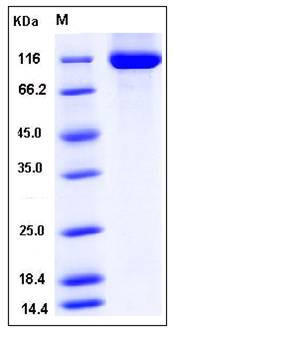Human RET Kinase Protein (His Tag)
CDHF12,CDHR16,HSCR1,MEN2A,MEN2B,MTC1,PTC,RET-ELE1,RET51
- 100ug (NPP4219) Please inquiry
| Catalog Number | P11997-H08H1 |
|---|---|
| Organism Species | Human |
| Host | Human Cells |
| Synonyms | CDHF12,CDHR16,HSCR1,MEN2A,MEN2B,MTC1,PTC,RET-ELE1,RET51 |
| Molecular Weight | The recombinant human RET consists of 618 amino acids and has a calculated molecular mass of 69.1 kDa. The apparent molecular mass of the protein is approximately 110-120 kDa in SDS-PAGE under reducing conditions. |
| predicted N | Leu 29 |
| SDS-PAGE |  |
| Purity | > 92 % as determined by SDS-PAGE |
| Protein Construction | A DNA sequence encoding the extracellular domain of human RET (P07949-1) (Met 1-Arg 635) was fused with a polyhistidine tag at the N-terminus. |
| Bio-activity | |
| Research Area | Cancer |Oncoprotein & suppressor & biomarker |Oncoprotein |Growth Factor & Receptor |Receptor Tyrosine Kinase (RTK) |
| Formulation | Lyophilized from sterile PBS, pH 7.4 1. Normally 5 % - 8 % trehalose and mannitol are added as protectants before lyophilization. Specific concentrations are included in the hardcopy of COA. |
| Background | RET proto-oncogene, also known as RET, is a cell-surface molecule that transduce signals for cell growth and differentiation. It contains 1 cadherin domain and 1 protein kinase domain. RET proto-oncogene belongs to the protein kinase superfamily, tyr protein kinase family. RET proto-oncogene is involved in numerous cellular mechanisms including cell proliferation, neuronal navigation, cell migration, and cell differentiation upon binding with glial cell derived neurotrophic factor family ligands. It phosphorylates PTK2/FAK1 and regulates both cell death/survival balance and positional information. RET is required for the molecular mechanisms orchestration during intestine organogenesis; involved in the development of enteric nervous system and renal organogenesis during embryonic life; promotes the formation of Peyer's patch-like structures; modulates cell adhesion via its cleavage; involved in the development of the neural crest. RET proto-oncogene is active in the absence of ligand, triggering apoptosis. RET acts as a dependence receptor; in the presence of the ligand GDNF in somatotrophs (within pituitary), promotes survival and down regulates growth hormone (GH) production, but triggers apoptosis in absence of GDNF. It also regulates nociceptor survival and size; triggers the differentiation of rapidly adapting (RA) mechanoreceptors; mediated several diseases such as neuroendocrine cancers. Defects in RET may cause colorectal cancer, hirschsprung disease type 1, medullary thyroid carcinoma, multiple neoplasia type 2B, susceptibility to pheochromocytoma, multiple neoplasia type 2A, thyroid papillary carcinoma and congenital central hypoventilation syndrome. |
| Reference |
